In Indian Geography, rocks and minerals, such as iron ore, bauxite, mica, copper, and coal, form the foundation of the nation’s geological diversity, shaping its landscapes and economic resources. From the igneous basalts of the Deccan Traps to sedimentary deposits of coal and bauxite, these resources drive industries and sustain agriculture across India.
Previous Year Question
| Year | Question | Marks |
| 2013 | What is the significance of Hugrijan Moran ? | 2 M |
| 2023 | Which are the important Bauxite mining areas of Odisha, Gujarat and Jharkhand in India? | 5 M |
General Introduction
‘Minerals’ – Those substances found in natural form, which have definite chemical physical properties and chemical composition. They are obtained through mining, excavation and drilling; They also have economic importance.
- India is endowed with abundant mineral deposits and produces 95 minerals, which include 4 fuels, 10 metals, 23 non-metals, 3 atomic and 55 minor minerals (including building and other materials).
Some of the basic characteristics of minerals are as follows:
- Their distribution on the earth is uneven.
- Most of the minerals are uncertain and non-renewable.
- Most of the minerals are found underground and require capital and labour for their excavation.
- No country is self-sufficient in the production of minerals.
- In India, till independence in 1947, 22 types of minerals were mined. Today their number has increased to 125. Out of these, 35 minerals are very important from the economic point of view. Till now, humans have knowledge of about 1600 types of minerals. In terms of self-reliance in minerals, the United States of America is at the first place, India at the second and Russia at the third.
- Most of the mineral areas in India are found in peninsular India. This is the reason that Jharkhand, Chhattisgarh, Madhya Pradesh, Odisha, Karnataka, Gujarat and Tamil Nadu are important states of the country from the point of view of mineral resources. The vast alluvial plains of North India are devoid of economically useful minerals.
- Most of the coal in India is found in the Gondwana rock group. Similarly, major metallic minerals of India such as iron, copper, lead, zinc, manganese etc. are found in the Dharwad and Cuddapah system and major non-metallic minerals such as limestone, dolomite, gypsum, calcium, sulphate etc. are found in the Cuddapah and Upper Vindhyan system
Classification of minerals
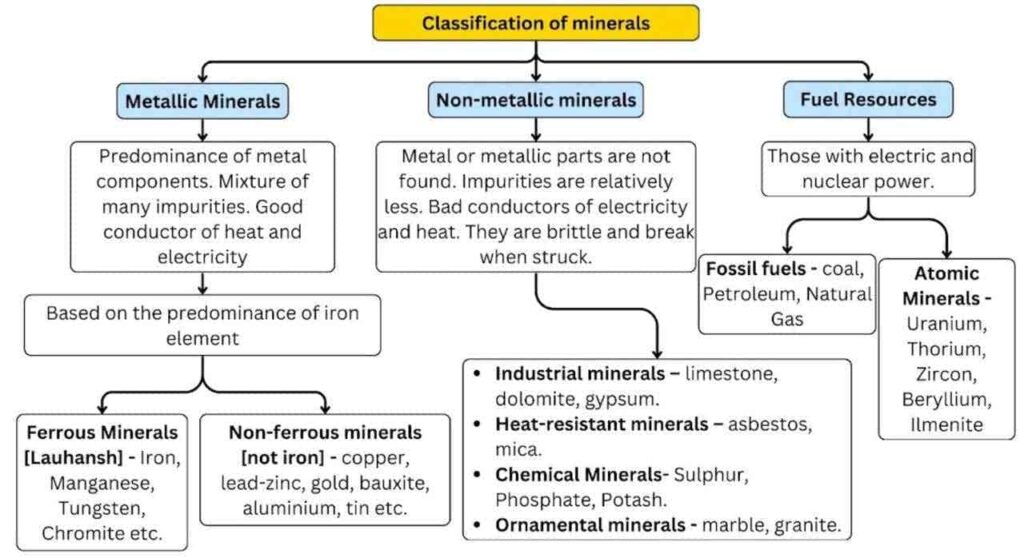
Mineral Belts
Most of the mineral wealth in India is concentrated in the peninsular plateau regions. Several belts of mineral wealth have been identified for the distribution of minerals in this plateau region. These belts are-
1. North-eastern plateau belt-
- Extension – Jharkhand, West Bengal, Bihar, Chhattisgarh and Odisha of Chotanagpur plateau. India’s most resource-rich region in terms of mineral resources.
- ”Heart of Indian Minerals’
- Due to the development of Dharwad and Gondwana type structures here, there are maximum deposits of mineral resources like iron ore, copper, mica, manganese and coal. Ilmenite, bauxite, chromite, phosphate etc.
- Due to the development of Kudappa structure, deposits of limestone are also found here.
- The ‘iron, steel and heavy engineering industry’ has developed the most here.
- Chhotanagpur Plateau – It is called the ‘Ruhr Pradesh’ of India.
2. intermediate belt –
- Extension – Madhya Pradesh, Eastern Maharashtra, Chhattisgarh and Telangana. In terms of mineral resource reserves, this is the second most important region of India.
- Deposits of iron ore, coal and copper are found here.
- The mining industry has developed due to the availability of mineral resources, but due to lack of infrastructure, other mineral resource based industries have not developed.
3. North-western belt or Aravalli belt-
- Includes the Aravalli hill ranges of Gujarat and Rajasthan.
- Due to the development of Dharwad and Cuddapah formations, there are considerable reserves of metallic and non-metallic mineral resources.
- The region is rich in building stones like copper, zinc, sandstone, granite, marble, gypsum and extensive deposits of Multani Mitti are also found here.
- Despite the availability of mineral resources, the mining industry has developed here on a limited scale.
4. Southern and South-Western Belt –
- Goa, Karnataka’s plateau region and Tamil Nadu’s high regions.
- This is the third most important region of peninsular India in terms of mineral resources reserves, but diverse mineral resources have not been developed in this belt.
- Due to the development of Dharwad structure here, there is the largest reserve of metallic mineral resource ‘iron ore’.
- Vast reserves of gold, iron ore, manganese, copper, bauxite, lignite, coal, limestone, gypsum, chromite etc. in Karnataka-Tamil Nadu belt.
- Minerals like monazite, thorium, zircon, ilmenite, garnet, clay etc. in Kerala belt.
5.Himalayan Belt – There is ample possibility of finding minerals like copper, lead, zinc, nickel, antimony, cobalt, tungsten, gold, silver, chromite and beryllium.
Along with this, in the offshore areas of the western and eastern coasts of the Indian Ocean, along with mineral oil and natural gas, modules of metals are also found in the bottom and deposits of mineral oil are also present in the Assam valley.
Major Minerals
Iron ore
- In the present mechanical age, iron is the pivot of the economic development of a country. From needles and nails to furniture, huge engines, vehicles, machines, ships, various equipment and building construction materials etc. are made from iron.
- The present age is called the Iron-Steel Age.
- The raw metal of iron is called iron ore. In India, it is obtained in black or ochre colour from sedimentary and igneous rocks of Dharwad era.
- Iron ore is found in impure state, which is cleaned by melting it in blast furnaces. The cold metal of cleaned iron is called raw iron. Different types of steel are prepared by mixing manganese, tungsten and nickel etc. in iron.
- The amount of iron in iron ore varies
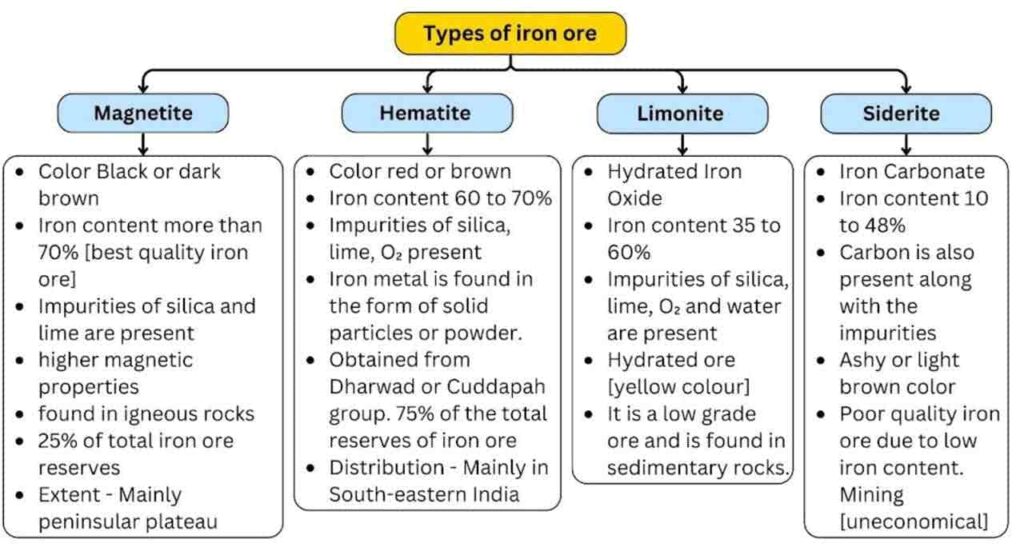
production
- India is the fourth largest iron ore producer in the world.
- India’s iron ore production is expected to be around 275 million metric tonnes in financial year 2023-24, a growth of 7.5% over the previous year [258 MMT].
- Odisha leads iron ore production with 54% share, followed by Karnataka (16%) and Chhattisgarh (15%). [2023 – 24]
Most productive state [IMY 2022]
Hematite deposits
- 79% of hematite ore reserves in India are found in the eastern region (Assam, Bihar, Chhattisgarh, Jharkhand, Odisha and Uttar Pradesh).
deposits of magnetite
- 93% of magnetite ore reserves are found in the southern region (Andhra Pradesh, Goa, Karnataka, Kerala and Tamil Nadu).
Iron ore production area –
|
State |
Production Areas |
|
Karnataka |
Magnetite – Chikkamagaluru [Kundremukh, Baba Budan Hills, Kemmangundi], Hassan, North & South Kannada, ShivamoggaHematite – Bagalkot, Bellary [Sandur Hills – USE in Vijayanagara Steel Plant], Hospet, Chitradurga, Dharwad, Davanagere, Gadag, Tumkur |
|
Note – India signed an agreement to export magnetite iron ore from Kundremukh to Iran. [From Mangalore Port] | |
|
Tamil Nadu |
Tiruvannamalai – Kavuthimalai and VediyappanamlaiSalem – Kanjamalai and GodumalaiTiruchirappalli, NamakkalDharmapuri, Erode, Nilgiris, Vilupuram |
|
Andhra Pradesh |
Magnetite – Anantapur, Kudappah, Guntur, Krishna, Kurnool, NelloreHematite – Prakasam |
|
Kerala |
Kozhikode, Malappuram |
|
Telangana |
Magnetite – Adilabad, Mahbubnagar, WarangalHematite – Karimnagar, Khammam |
|
Odisha |
Magnetite – Kendujhar, Mayurbhanj [Badam Hills, Gurumahisani, Sulepat]Hematite – Sundergarh [Bonaigad Range, Kandadhar Hills], Keonjhar [Barbil Koira Valley, Bansapani, Toda], Cuttack Tomka Range, Sambalpur, Koraput, Hirapur Hills Dhenkanal, Jajpur [Kalinganagar] |
|
Chhattisgarh |
Rajnandgaon – Raoghat, Chargaon, Metabodeli and Haldi deposits, Boria Tibbu deposit,Balod [Durg] – Dalli-Rajhara area, BastarDantewada – Bailadila [Country’s largest mechanized iron ore mine, exports to Japan, South Korea, and China from Visakhapatnam port.]Kanker – Small Dongar deposits; Ari DongriBailadila-Raoghat hill ranges are the largest iron ore regions of India in the state. |
|
Jharkhand |
Magnetite – East Singhbhum, Gumla, Hazaribagh, Latehar, Palamu, Daltonganj, Sindurpur.Hematite – West Singhbhum – Noamandi, Gua, Chiria, Baramjada, Kiriburu and Meghataburu] |
|
MadhyaPradesh |
Betul, Gwalior, Jabalpur and Katni |
|
Maharashtra |
Ratnagiri, Gadchiroli and Sindhudurg, GondiaChanda/Chandrapur – Peepal village, Lohar, Dewalgaon |
|
Goa |
In the valleys of the Mandovi and Zuari rivers. Mirna, Adonpol, Asnar, Sonshi Senkulam, Paunda.Kundem Surla, Kundem Princesalem.Sirigao, Bicholim Dalda.Export to Japan from Marmagoa Port. |
|
Rajasthan |
Udaipur, Thur Hunder, Nathra Ki Pal |
|
|
Iron ore belts in India
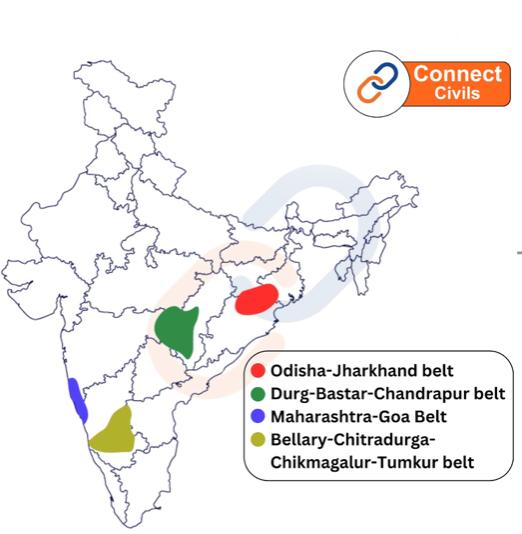
Copper
- In India, copper is found in the ancient crystalline structures of Dharwad and Cuddapah.
- Copper has been important in the development of human civilization.
- Uses – Used in making wires, electrical equipment (motors, transformers, generators), pipes and utensils.
- Due to its flexibility and ductility, it is mixed with other metals to form alloys like brass (copper + aluminum), bronze (copper + tin), German silver (copper + nickel) and rolled gold (copper + gold).
- The production of copper in India is much less than the demand. India imports copper in large quantities. India mainly imports copper from countries like the United States of America, Canada, Zimbabwe, Japan, Mexico, etc.
Production
- India ranks 11th in the world in copper metal production (refined).
- Tentative production of copper in 2023-24 is 125 thousand tonnes, an increase of about 11.1% compared to last year.
- Copper is produced only in Rajasthan and Madhya Pradesh.
| State | Production Area |
| Madhya pardesh | Malajkhand region (Balaghat district), Tare village, Betul district |
| Rajasthan | Alwar, Jhunjhunu, Khetri, Udaipur, Bhilwara, Sikar, Dungarpur |
| Jharkhand | Ghatshila, Surda (East Singhbhum district), Sonamakhi, Mosabani, Rajdah, Palamu, Santhal, Pargana, Hazaribagh, Manbhum. |
| Andhra Pradesh | Guntur, Kurnool, Nellore, Anantapur |
| Sikkim | Bhotang, Rotok, Dikue, Gisni, Sirbong, Jugudum |
Manganese
- Black coloured hard metal, found mainly in Dharwar formations.
- Manganese is silvery grey in colour and is very hard and brittle in nature.
- India is a major exporter of manganese, though India exports only raw manganese.
- Ore – Pyrolusite, Psilomelane, Manganite, Braunite.
- Uses of Manganese
- Mainly in making stainless steel [about 10 kg of manganese ore is required to make 1 ton of steel]
- Dry-cell batteries, bleaching powder, fungicides, insecticides, paint and glass industries and photography.
- In rifle barrels, railway tracks, safes, prison bars.
- In the production of a variety of important alloys, for deoxidized steel and desulfurase in the production of steel.
Manganese Ore Distribution in India
- Reserves – Zimbabwe > India
- India’s world rank in manganese ore production – 7th
- Indian manganese ore reserves occur mainly as metamorphosed bedded sedimentary deposits belonging to the gondite and codurite series of the Archaean groups.
Manganese Ore Production –
- The provisional production of manganese ore in 2023-24 was 3.4 million tonnes, an increase of about 21.7% over the previous year.
- The largest producing states were Madhya Pradesh, Maharashtra and Odisha.
manganese deposits
- The total reserves/resources of manganese ore in the country are estimated at 503.62 million tonnes.
Production-2023-24:
| BeltsBalaghat – Bhandara – Nagpur belt205 km long, 16 km wide, 25 m deep – spread across Madhya Pradesh and Maharashtra.Expansion – From Balaghat, Chhindwara of Madhya Pradesh to Nagpur and Bhandara districts of Maharashtra.78% reserves presentSinghbhum – Keonjhar – Bonai belt – 11% reservesNorthern Kannada – 6% | |
| State | Production |
| MP [30%] | Balaghat, Chhindwara, Nimar, Mandla and Jhabua, Jabalpur, Dewas, Shahdol. |
| Maharastra [30%] | Nagpur, Bhandara, Ratnagiri. |
| odisha [19%] | Kendujhar, Bolangir, Sambalpur, Koraput, Sundergarh, Bonai, Keonjhar, Kalahandi, Ganjam and Gangpur |
| Karnataka | Uttara Kannada, Shimoga, Bellary, Belagavi, Chitradurga and Tumkur, Dharwad, Chikmagaluru. |
| AP [10%] | Srikakulam, Vizianagaram, Visakhapatnam, Cuddapah and Guntur. |
| Telangana | Adilabad district |
| Gujarat | Panchmahal and Vadodara |
| Rajasthan | Udaipur banswara |
| jharkhand | Singhbhum and Dhanbad |
Export of Manganese
- 4/5th of total production is consumed domestically.
- Exports are steadily declining due to increasing domestic demand.
- Japan is the largest buyer of Indian manganese.
- Other buyers are USA, UK, Germany, France, Norway.
Bauxite
- It is an oxide of aluminium. It can be white, pink or red in colour depending on the iron content in it.
- India’s bauxite resources are sufficient to keep the country self-sufficient.
- It is found in tertiary formations.
- It is mainly found in the plateau regions and mountain ranges of peninsular India as well as in the coastal areas.
- Uses – Used in machinery manufacturing, leather dyeing, petrol and salt refineries etc. Also used for the manufacture of white cement and some chemicals.
- Bauxite is found near the surface and is usually mined by highly mechanised open cast methods.
- 80% of bauxite is used in the aluminium industry.
Bauxite Distribution in India
- India’s rank in world in bauxite production – Fifth
- The provisional production of bauxite in 2023-24 was 23.72 million tonnes, a decrease of 0.5% over the previous year.
- Odisha is the leading state in bauxite production [74.2%].
- Bauxite reserves in India are mainly found in Amarkantak plateau, Maikal hills and Bilaspur-Katni plateau region.
bauxite reserves
- As per NMI database (UNFC system), the country has total bauxite resources of 4,958 million tonnes, of which 646 million tonnes are reserves and 4311 million tonnes are remaining resources.
Production –
Odisha (74.2%) > Jharkhand (9%) > Gujarat (7%)
|
State |
Production Area |
|
Odisha |
Kalahandi, Panchpatmali (Koraput), Gandhamardan Deposit (Bargarh), Sundergarh, Bolangir, Sambalpur, Kandhamal, Kyonjhar, Malkangiri, Rayagada.Note – Kalahandi and Koraput districts are the largest bauxite areas in India. |
|
Gujarat |
Amreli, Bhavnagar, Dwarka, Jamnagar, Junagadh, Kheda, Kutch, Porbandar, Sabarkantha, Haldar, Surat and Valsad. |
|
jharkhand |
Palamu, Lohardaga [high category], Latehar, Ranchi, Gumla, Dumka and Munger, Shahabad. |
|
Chattisgarh |
Balrampur, Bilaspur, Dantewada, Kanker, Kawardha (Kabirdham), Korba, Raigarh and Surguja, Rajnandgaon, Durg. |
|
Maharashtra |
Kolhapur, Ratnagiri, Thane, Satara, Colaba, Pune. |
|
Tamil Nadu |
Nilgiri Hills, Maturai, Salem, Coimbatore. |
|
MP |
Shahdol, Mandla, Katni, Satna, Shivpuri, Jabalpur, Maikal Range, Balaghat. |
|
Karnataka |
North and South Kannada, Baba Budan Hill Area, Belgaum (Belagavi), Chikkamagaluru. |
|
Andhra Pradesh |
Visakhapatnam, East Godavari, and West Godavari),Vijayanagar, Srikakukulam. |
|
Kerala |
Kerala: Kannur, Kollam, Thiruvananthapuram |
|
UP (Banda, Lalitpur, Varanasi), Rajasthan (Kota), Jammu and Kashmir (Jammu, Poonch, Udhampur) and Goa. |
Mica
- Mica is a light mineral. It is found in layers in igneous and metamorphic rocks.
- Mica is white, black or green in colour. Pieces of white mica are found only in igneous rocks called pegmatites. It is also called ‘ruby mica’ or ‘muscovite mica’. It is the best quality of mica.
- use –
- Mica is used in the manufacture of electrical equipment, wireless cables, computers, aircrafts etc. due to its flexibility, transparency and poor conductivity of electricity and heat.
- Its powder can be mixed with spirit and sheets of any shape can be made.
- In toothpaste and cosmetics. It also works as a mild abrasive in toothpaste.
Mica Production
- About 80% of the world’s mica is produced in India.
- India is the largest exporter of mica (through Kolkata and Visakhapatnam ports).
- Important importers of Indian mica are Japan (19%), USA(17%), UK etc.
Mica distribution in India
|
State |
Production Area |
|
AP 1st |
Nellore (best quality), Krishna, Visakhapatnam, Anantapur, Khammam, Guntur, West Godavari. |
|
Rajasthan2nd |
Jaipur, Bhilwara, Udaipur, Ajmer, Udaipur. |
|
Jharkhand: 3rd |
Koderma Gaya-Hazaribagh Belt [150 km. long and 22 km. wide belt]Koderma (largest mica deposit in the world) – Domchanch, Dhorhkola, Dhaba, Chakpathal. |
|
Bihar |
Gaya, Munger, Bhagalpur, Nawada, Jamui, Banka |
|
Odisha, Maharashtra (Ratnagiri), Karnataka (Mysore and Hassan), TN (Coimbatore, Tiruchirappalli, Madurai and Kanyakumari), Kerala (Alleppey district), WB (Purulia, Bankura) |
Limestone
- Limestone is found in sedimentary rocks of all ages except Gondwana. They are mainly found in the Cuddapah and Vindhyan rock groups.
- Andhra Pradesh has the largest limestone reserves in India. Rajasthan, Karnataka, Madhya Pradesh, Gujarat, Odisha, Chhattisgarh and Tamil Nadu are other producing centres.
- Limestone production reached 451 million tonnes in 2023-24 [an increase of 11% over the previous year].
- Limestone is produced extensively in India.
- Rajasthan, Madhya Pradesh and Andhra Pradesh together account for 50% of the limestone production in the country.
|
State |
Production |
|
AP |
Visakhapatnam, Krishna, Guntur, Kurnool |
|
MP |
Balaghat, Jabalpur, Satna, Betul, Sagar, Katni |
|
Chhattisgarh |
Bilaspur, Durg, Raigarh, Bastar, Raipur |
|
Rajasthan |
Ajmer, Bikaner, Jodhpur, Kota, Sirohi, Bundi, Alwar, Sawai Madhopur, Chittor, Nagaur, Jhunjhunu, Udaipur |
|
Gujarat |
Banaskantha, Junagadh, Kheda, Panchmahal, Sabarkantha |
|
Karnataka |
Bijapur, Belgaum, Shimoga, Gulbarga |
|
Tamilnadu |
Ramanathapuram, Tirunelveli, Tiruchirappalli, Salem, Koyamputtur, Maturai, Thanjavur |
Gold
- In India, gold is found as ‘placer deposits’ in the rocks of the Dharwad Formation and in river sands.
- Gold is the major importable mineral in India.
- Provisional production of primary gold in 2023-24 was 1,552 kg [an increase of 8.3% over the previous year].
- Production – Karnataka [93%+] > Andhra Pradesh > Jharkhand.
| State | Production Area |
| Karnataka | Kolar, Champion Reef, Hatti in Raichur district |
| Andhra Pradesh | Anantapur, Chittoor area |
| Jharkhand | Swarna rekha River |
Silver
- Silver is generally found in mixed form in the producing areas of zinc, lead and copper.
- Significant deposits of silver are found in Andhra Pradesh, Rajasthan and Jharkhand.
- Major ores – Argentite, Pyrajyrite and Horn Silver.
- In India, the maximum production of silver is from Rajasthan. Zinc mines of Udaipur and Chittorgarh are famous for the production of silver.
|
State |
Production |
|
Karnataka |
Chitradurga, Bellary |
|
Andhra Pradesh |
Cuddapah, Guntur, Kurnool |
|
Rajasthan |
Javar |
|
Uttarakhand |
almoda |
Diamond
- The purest allotrope of carbon.
- Formation – Due to the effect of extreme heat and pressure in the inner layers of the earth.
- Black diamonds are used for cutting glass, drilling holes in rocks etc.
|
state |
Production area |
|
MP |
Panna |
|
Andhra Pradesh |
golkunda |
|
Chattisgarh |
raipur |
Zinc
- Zinc is usually obtained from sedimentary rocks.
- Use – Mainly to make iron rust-proof and for polishing.
- In India, Rajasthan has a monopoly in terms of zinc production and reserves. Here, Bhilwara, Alwar, Jawar (Udaipur), Rajsamand, Chittor etc. areas are the major zinc producing areas.
- The estimated lead concentrate production for 2023-24 was 381 thousand tonnes [increase of 1%]. Zinc concentrate production was 1,710 thousand tonnes [decrease of 2.4%].
- The entire production of both lead and zinc concentrate during 2023-24 will be in Rajasthan.
|
State |
Production Area |
|
Rajasthan |
Udaipur, Rajsamand, Chittor, Bhilwara, Rampur Aagucha area |
|
Tamil Nadu |
South Arcot |
|
Jammu Kashmir |
Udhampur |
Lead
- Lead is mainly obtained from an ore called ‘Galena’.
- It is not found in free form in nature.
- It is mainly found in Precambrian and Vindhyan rocks
- Hindustan Zinc Limited has been established in Jawar area of Rajasthan for the production of lead.
|
State |
Production Area |
|
Rajasthan |
Zawar (Udaipur), Rampura, Agucha (Bhilwara) |
|
Chhattisgarh |
Durg, Raipur, Bastar, Dantewada |
Graphite
- Graphite is mainly found in igneous and metamorphic rocks. It is also called ‘crystalline carbon’ and ‘black lead’. It is an allotrope of carbon.
- Uses: For making pencil leads and as a moderator in nuclear reactors.
|
State |
Production Area |
|
Tamil nadu |
madurai |
|
Jharkhand |
Latehar, Palamu |
|
odisha |
Kalahandi, Balangir Ganjam, Kotapur |
|
Rajasthan |
Jaipur, Ajmer, Alwar, Banswara |
|
MP |
Betul |
Gypsum
- It is found in limestone, sandstone and shale rocks. It is a hydrated sulphide of calcium.
- It is used in making ammonium sulphate, chemical fertilisers and cement.
|
State |
Production Area |
|
Rajasthan |
Nagaur, Bikaner, Barmer, Jaisalmer, Jodhpur, Sri Ganganagar |
|
Himachal Pradesh |
Sirmour, Kangra, Shimla |
|
Maharastra |
kolhapur |
|
Karnataka |
Belgaon,gulbarga |
|
UP |
Jhansi,hamirpur |
|
Tamil Nadu |
Koyamputtur, Tiruchirappalli |
|
Jammu Kashmir |
Uri, Baramulla, Doda |
Other major minerals
|
Mineral |
Properties |
|
Chromite |
Production in 2023-24 – 3.14 million tonnes.Production- Odisha (100%) , Karnataka. |
|
dolomite |
A mixture of limestone and magnesium.Production – Bilaspur in Chhattisgarh [top position], Cuddapah in Andhra Pradesh and Sambalpur and Koraput in Odisha. |
|
Marble |
A type of metamorphic rock.Mainly used in building construction.The Makrana region of Rajasthan is famous for high quality marble. |
|
Barytes |
According to the data of the year 2017, Andhra Pradesh (Cuddapah) is the top barite producing state of India. |
|
pyrite |
Besides being iron sulphide, it is also a major source of sulphur.Rohtas district of Bihar is the most prominent in the production of pyrite. |
|
Appright |
It is used in making phosphate fertilizer and phosphoric acid.About 95% of apatite reserves are found in the states of West Bengal, Jharkhand and Meghalaya. |
|
Kyanite |
Uses – In lead, cement and porcelain industry because it is a melt-resistant mineral.Production – Mainly in Singhbhum and Dhanbad of Jharkhand and Maharashtra. Also found in Bhilwara and Udaipur of Rajasthan. |
|
Magnesite |
Uses – As a thermal insulating material, in making bricks and liquid carbon dioxide, in food processing industry and in making fertilizers.Procured from igneous rocks.In 2023-24, production was 132 thousand tonnes [an increase of 23% over the previous year].Tamil Nadu and Uttarakhand produce over 94% of India’s magnesit |
|
sillimanite |
This is also a type of heat-resistant mineral.Use – In lead industry.Production – Mainly Odisha, Tamil Nadu and Uttar Pradesh. |
|
Steatite |
Obtained from igneous and metamorphic rocks.It is also compared to ‘soapstone’.Used in making soap, cosmetics and colours. |
Coal
- Coal is mainly the carbonized remains of plants. It is usually a solid stratified rock made of hydrocarbons.
- This combustible mineral is made up of organic matter. Carbon, hydrogen, oxygen, phosphorus, sulfur etc. are found in these organic matter.
- Major Uses –
- For thermal power generation and smelting of iron ore.
- It is used for metallurgical work in the extraction of minerals like iron, zinc etc. and in the production of coal gas, water gas, tar, coke, fertilizers and various types of varnishes and insecticides.
- Coal is also called the ‘mother of industries’.
- Coal develops slowly due to ‘heat and pressure’ on vegetation buried in the earth for millions of years.
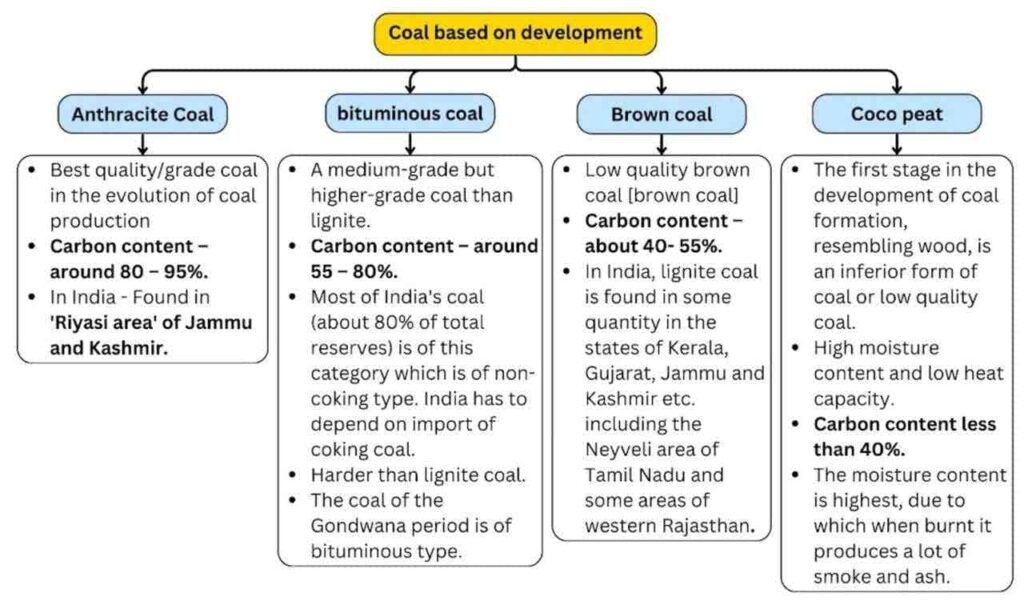
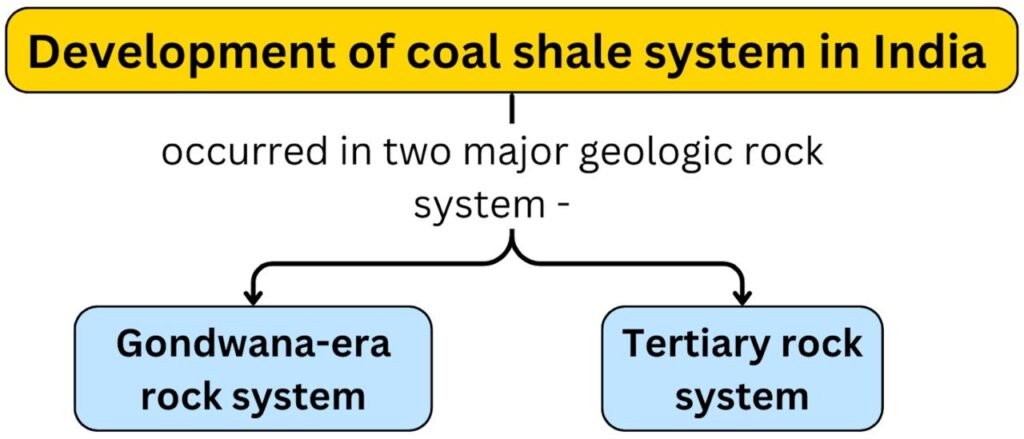
1. Gondwana-era rock system
- About 250 million years old rock system.
- It gives high quality coal i.e. it has less ash content and high heat production power.
- Most of the coal in India (more than 95%) is obtained from the rocks of Gondwana system.
- The coal of Gondwana period is mainly of bituminous type. It is also called ‘refining coal’ because the amount of sulphur in it is very less, due to which it is considered best for industries.
- Major areas – Damodar Valley, Godavari Valley, Son River Valley, Mahanadi Valley and Wardha River Valley.
- The major resources of Gondwana coal are in the coal areas located in West Bengal, Jharkhand, Orissa, Chhattisgarh, Madhya Pradesh, Maharashtra and Andhra Pradesh.
2. Tertiary rock system
- About 50 million years old rock system.
- The coal of this sequence has high ash and sulphur content and low heat-producing power, hence it is not used in industries.
- Main areas- North-eastern states, mainly Meghalaya, Assam, Arunachal Pradesh and Nagaland.
- It is extracted in Darangir, Cherrapunji, Mawlang and Langrin (Meghalaya); Makum, Jaipur and Nazira Namchik-Namphuk (Arunachal Pradesh) and Kalakot (Jammu-Kashmir) in Upper Assam.
Apart from this, brown coal or lignite is also found in the coastal areas of Tamil Nadu, Pondicherry, Gujarat and Jammu and Kashmir.
Coal production areas in India
- The country has produced the highest ever coal production in the financial year 2023-24.
- All India coal production in the financial year 2023-24 was 997.23 MT with an increase of about 11.65%
Note – Coking coal is being imported by the steel sector mainly to bridge the gap between requirement and indigenous availability and to improve quality. Other sectors like power sector, cement etc. and coal traders are importing non-coking coal.
coal reserves
- India has a total geological coal resource of 361.411 billion tonnes up to a depth of 1,200 metres.
Production [2022 – 23]
Lignite
- Lignite deposits in India are mainly found in the tertiary sedimentary rocks of the southern and western peninsular region. These are located in Tamil Nadu, Puducherry, Gujarat, Rajasthan, Jammu and Kashmir and Odisha.
- The total known geological lignite resources in the country as on 01 April 2022 are about 46.024 billion tonnes.
- Tamil Nadu has 79.3% (about 36.56 billion tonnes), while Rajasthan has 13.98% and Gujarat has 5.89% reserves.
Lignite Production [2022 – Rank 23]
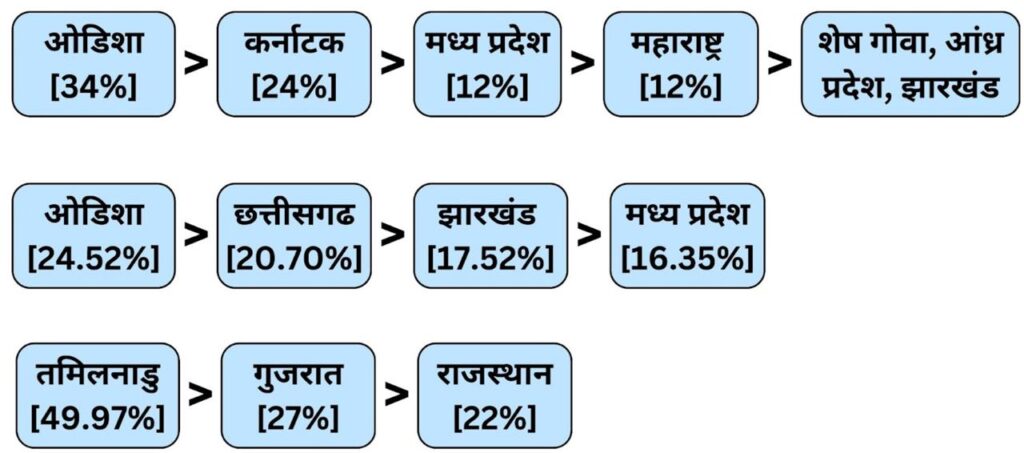
Major coal producing regions in India
|
Damodar River Valley |
|
|
Son River Valley |
|
|
Mahanadi Valley |
|
|
Godawari River |
|
Apart from these areas, coal is also obtained from Chanda Wardha, Kampti and Bander in Maharashtra; Satpura hilly areas (Narsinghpur, Singrauli, Sidhi, Chhindwara, Betul, Shahdol, Anuppur, Umaria), Rajmahal hilly areas (Lalmatia) and Pandur in Andhra Pradesh.
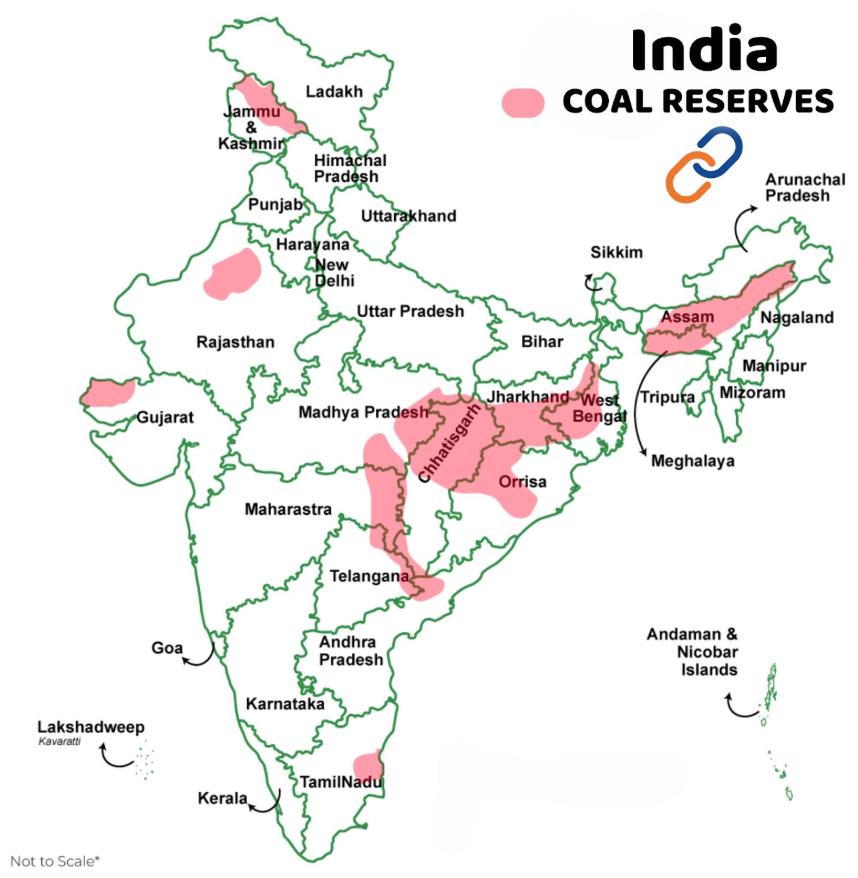
Mineral Oil and Natural Gas
- Crude petroleum consists of hydrocarbons in liquid and gaseous state and varies in chemical composition, colour and specific gravity.
- It is an essential source of energy for internal combustion fuel of motor vehicles, railways and aircraft. Many of its co-products are used in petrochemical industries, such as fertilizers, synthetic rubber, synthetic fibres, medicines, vaseline, lubricants, waxes.
- Mineral oil and natural gas develop in fossiliferous sedimentary rocks.
- In the underground of rocks, natural gas is found at the top, mineral oil below it and water at the bottom.
- Mineral oil contains 90-95% hydrocarbons and 5-10% other elements.
- Hydrocarbons comprise 70% oil and 30% natural gas.
- Most of India’s oil reserves are associated with sedimentary rocks of tertiary age.
- History of Oil Exploration in India
- The first well was dug in 1867 at Makum (Assam).
- Production started in 1889 from Digboi.
- Oil India Limited (OIL) and ONGC carry out oil exploration work.
- Transmission and distribution of natural gas is done by GAIL India Limited.
- There is a huge shortage of mineral oil in India compared to its energy needs, so India has to depend on its import. This sector has the largest share in India’s import account.
- The eight major industries in India include crude oil, natural gas and petroleum refinery products.
- In FY 2023-24, India produced 29.4 million metric tonnes (MMT) of crude oil and 36.4 billion cubic metres (BCM) of natural gas while imported 234.3 MMT crude oil, 48.7 MMT petroleum products and 31.7 BCM liquefied natural gas (LNG) to meet the growing energy demand.
- In terms of natural gas storage, Eastern offshore, Western offshore, Assam, Andhra Pradesh, Rajasthan, Gujarat are ranked respectively, while in terms of production, Assam, Gujarat and Rajasthan are ranked respectively.
- In India, Assam, Gujarat and Rajasthan rank first, second and third respectively in petroleum storage, whereas in its production, Rajasthan ranks first, Gujarat second and Assam third.
oil refineries in india
- India’s first oil refinery was established in 1901 in the Digboi area of Assam state before independence.
- Later, the first oil refinery of independent India was established in Mumbai (Maharashtra) in 1954.
| major oil refineries in india | ||
| Oil refinery | company | state |
| Jamnagar | Reliance | Gujarat(pvt Sector) |
| Koyli | IOCL | Gujarat |
| Mangalore | MRPL | Karnataka |
| Kocchi | BPCL | kerala |
| mathura | IOCL | up |
| paradweep | IOCL | odisha |
| vishakhapattnam | HPCL | AP |
| Mumbai | BPCL | Maharastra |
| Haldia | CPCL (locl) | West Bengal |
| Bhatinda | HPCL | Punjab |
| Barouni | IOCL | Bihar |
| Numaligarh | NRL | Assam |
| Tatipaka | ONGC | AP |
| Panipat | IOCL | Hariyana |
| Nagpattinam | CPCL (IOCL) | Tamil Naddu |
| 23 refineries with a total installed capacity of 256.8 MMTPA (4th largest refiner globally). | ||
Note –
- India has made significant progress in biofuels, achieving the target of 10% ethanol blending in gasoline in June 2022, ahead of schedule.
- The country is encouraged to pursue a 20% ethanol blending target from 2030 to 2025-26.
- The government has also introduced blending requirements for other biofuels in compressed natural gas (5% blending obligation in CNG (transport) and PNG (domestic) by 2029), biodiesel – (indicative target of 5% blending by 2030), and sustainable aviation fuel – (indicative blending of 2% for international flights by 2028).
Energy Resources
Major Uranium fields in India
- Jharkhand – Singhbhum District (Jadugoda, Bhatin, Narwa Pahad, Turamdih)
- Meghalaya Domiasiat
- Rajasthan – Rohil Ghateshwar (Sikar District), Udaipur, Alwar, Jhunjhunu
- Andhra Pradesh – YSR (Cuddapa), Nellore District,
- Telangana – Lambapur (Nalgonda)
- Karnataka – Gulbarga, Gogi
- Himachal Pradesh – Kullu District
- Uttarakhand – Dehradun, Chamoli
- Chhattisgarh – Durg
- Maharashtra – Mogra
- Uttar Pradesh – Lalitpur
Major Thorium fields in India
- Kerala – Kollam
- Tamil Nadu – Kanyakumari, Maturai
- Andhra Pradesh – Visakhapatnam
- Monazite sand off Odisha coast
- Jharkhand – Hazaribagh
- West Bengal
| nuclear power station | Location |
| Tarapur (country’s first) | Maharashtra (with US assistance) |
| Koodankulam | Tamil Nadu (with Russian assistance) |
| Rawatbhata (25th in the country) | Rajasthan (with Canadian assistance) |
| Narora | UP |
| Kaiga (20th nuclear power plant in the country) | Karnataka |
| Kakarapara | Gujarat |
| Kalpakkam | Tamil Nadu |
| Jaitpur | Maharastra |
Major Beryllium fields in India
- Jharkhand, Andhra Pradesh, Rajasthan, Madhya Pradesh, Tamil Nadu, Jammu & Kashmir, Sikkim etc.
Major graphite regions in India
- Kalahandi, Ganjam (Odisha), Bhagalpur (Bihar), Visakhapatnam (Andhra Pradesh), Warangal (Telangana), Tirunelveli (Tamil Nadu), Jaipur, Ajmer (Rajasthan), Almora (Uttarakhand), Mysore (Karnataka).
Major Lithium fields in India
- Mandya (Karnataka), Munger (Bihar), Hazaribagh (Jharkhand), Bhilwara (Rajasthan), Bastar (Chhattisgarh).
Major atomic minerals and their characteristics
|
minerals |
characteristics |
|
thorium |
|
|
Monazite |
|
|
Uranium |
|
|
Beryllium |
|
|
Zirconium |
|
|
antimony |
|
|
molybdenum |
|
Problems arising from overexploitation of mineral resources
- Due to uncontrolled exploitation of minerals, many important minerals are on the verge of complete extinction.
- Excavation of minerals has caused environmental problems. Agriculture and forest wealth are affected the most by this. Mining in hilly areas has increased the problem of landslides.
- The problem of water pollution has increased due to the flow of mineral waste etc. into water, which is the cause of many health related diseases.
- Discovery of new mineral areas leads to displacement of local people, which creates other social problems.
Conservation of Mineral Resources
- Remote sensing technology: Exploration of new mineral fields and identification of possibilities.
- Recycling: Recycling of available resources should be increased.
- Efficient use: Efficient and judicious use of minerals should be encouraged.
- Technological advancement: Substitution of resources by using advanced technology in place of traditional materials (e.g. plastic produced from petro-chemical industry in place of traditional brass or clay pots).
Pradhan Mantri Khanij Kshetra Kalyan Yojana (PMKKKY)
- In September 2015, under the Pradhan Mantri Khanij Kshetra Kalyan Yojana, a target has been set to improve the living standards of mining-affected people, under which all state governments have been directed to spend the funds of the District Mineral Foundation in a better manner.
- Keeping in view the development, social and economic conditions and long-term prospects, three targets have been set for the Pradhan Mantri Khanij Kshetra Kalyan Yojana-
- Ensuring long term, sustainable livelihoods for people affected by the mining sector.
- Implementation of various developmental and welfare projects/programmes in mining affected areas in consonance with the existing schemes/projects of State and Central Government.
- Minimizing the adverse effects on environment, health and socio-economic status of people engaged in mining.
National Mineral Policy, 2019
- In February 2019, the Union Cabinet approved the new National Mineral Policy, 2019 which will replace the existing National Mineral Policy 2008.
Aim
- The aim is to develop effective, meaningful and implementable policy that will promote improved transparency, regulation and enforcement, balanced social and economic development as well as long-term and sustainable mining practices.
Key features of the policy
- The policy encourages private sector funding and investment by giving industry status to mining activity.
- Special emphasis has been laid on the use of coastal waterways, inland shipping and dedicated mineral corridors for mineral evacuation and transportation.
- There is a provision to rationalize the unutilized reserved areas given to public sector undertakings and open them for private participation through auction.
- Exploration and private investment have been encouraged by adjusting taxes, levies and royalty rates in line with global norms.
- Equitable development of project affected areas will be ensured through long-term import-export arrangement and ‘District Mineral Fund’.
- The auction process on the basis of ‘right of first refusal’ and revenue share for RP/PL holders will also be implemented.
| Mines and Minerals (Development and Regulation) Amendment Act, 2023 – This Act is enacted to amend the Mines and Minerals (Development and Regulation) Act, 1957. |
Rocks and Minerals / Rocks and Minerals / Rocks and Minerals / Rocks and Minerals / Rocks and Minerals / Rocks and Minerals / Rocks and Minerals / Rocks and Minerals/ Rocks and Minerals Rocks and Minerals / Rocks and Minerals / Rocks and Minerals / Rocks and Minerals /Rocks and Minerals / Rocks and Minerals / Rocks and Minerals / Rocks and Minerals / Rocks and Minerals / Rocks and Minerals / Rocks and Minerals / Rocks and Minerals / Rocks and Minerals /
